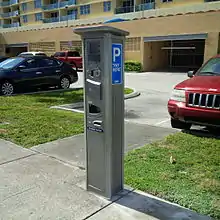Pay-by-plate machines are a subset of ticket machines used for regulating parking in urban areas or in parking lots. They enable customers to purchase parking time by using their license plate number. The machines print a receipt that generally displays the location, machine number, start time, expiration time, amount paid, and license plate.
Principles
The pay-by-plate system services multiple vehicles by making the driver input the license plate information into a machine. This system results in lower setup costs and less maintenance, but prevents drivers from taking advantage of parking meters that have time remaining. In many cities, pay-by-plate has replaced the roadside parking meter and the pay and display machines. The advantage to the city could be: increased revenue, increased compliance, fewer disputed tickets, increased parking space utilization and/or reduction in staff [see Results section].
The advantage to the driver is that the vehicle could be moved to another parking spot and still have a paid status compared to other systems. Previously with parking meters and pay by space, the payment did not follow the driver which resulted in a parking ticket if they decided to move spaces. In addition to this advantage, the driver could also purchase time by phone so that the driver does not have to go back to the machine to extend their parking session. The pay by plate machines accept coins, credit cards, debit cards and NFC for smart phone payments,[1] making it unnecessary for drivers to carry large amounts of change. The use of debit cards, credit cards and NFC are also advantageous to the city as they do not have to empty the machines as often lowering the cost of maintenance. It can also help to limit pilfering by employees who empty the parking meters.
Enforcement
Enforcement of license plates is done in one of three ways: by manual plate entry into a handheld device, by Automated License Plate Recognition (ALPR) in a handheld device or by vehicle mounted ALPR. The enforcement officer enters the plate manually or automatically depending on the technology used, and the system looks up payment information to see if the vehicle is parked legally. Illegally parked vehicles are issued a citation in real-time on the windshield or through a post-processed mail out method. Payments are retrieved from multiple sources from phone payments to on street payment machines. This process allows the parking enforcement officer to quickly determine who has and has not paid resulting in larger revenues for the city through citations and/or compliance.
Hand Held
Manual hand held devices look up the plate that the user manually enters. This method is prone to human error for data entry and has no photographic evidence to save (without separately taking a photo). Hand held ALPR comes in two flavors: ones that take single shot pictures to run ALPR against, and ones that run the camera in video mode performing ALPR on the stream of images. The single shot method takes longer but the full resolution of the camera is at its disposal. The live video mode is limited to the resolution of the video stream but has the advantage of running multiple images from subtly different angles. To date there has been no study as to which method results in the best ALPR read on a handheld device but arguments could be made for and against both.
Handheld devices have the advantage over vehicle mounted systems of being cheaper and able to enforce vehicles in tight spaces that an enforcement vehicle could not reach. There are also states and provinces that only have a license plate on the rear of the vehicle, making vehicle mounted ALPR impossible on vehicles that are backed into a parking space. However, handheld systems cannot match the efficiency of a vehicle mounted ALPR system travelling upwards of 60 km/h.
Vehicle Mounted ALPR
See main article: Automatic number plate recognition In mobile systems.
As it pertains to pay by plate, the payments are either pushed or pulled from a web service so that the enforcement vehicle always has up to date payment information. ALPR enabled parking enforcement vehicles typically travel at speeds upwards of 60 km/h all the while checking multiple license plates per second and verifying payment. Handheld systems cannot match the efficiency of this, however vehicle mounted ALPR systems are typically a magnitude more expensive. As mentioned before, vehicle mounted ALPR systems are not suited for all areas where an enforcement vehicle cannot "see" the license plate due to parking angle, plate placement, road geometry, etc. In those areas, handhelds are the best option.
Installations
In Canada, the first pay-by-plate system was unveiled in Calgary, AB on September 20, 2007.[2]

Pittsburgh, PA is implementing the largest Pay-by-Plate parking terminal project in the USA. This project has started on July 26, 2012. As of January 2013, Pittsburgh Parking Authority has completed the installation of 550+ Pay-by-Plate parking terminals. Every Parking Terminal is modem enabled, and is transmigrating all payments for parking in real-time. [3]
See also

References
- ↑ Swedberg, Claire (February 2008). "San Francisco Launches NFC Payment for All Its Metered Parking". RFID Journal. RFID Journal. Retrieved 2016-06-01.
- ↑ "Downtown Calgary Goes ParkPlus" (PDF) (Press release). Calgary Parking Authority. 2007-09-20. Archived from the original (PDF) on 2012-04-25. Retrieved 2011-10-14.
- ↑ Smydo, Joe (20 July 2012). "Pay-by-plate parking starts next week". Pittsburgh Post-Gazette. Retrieved 20 July 2012.